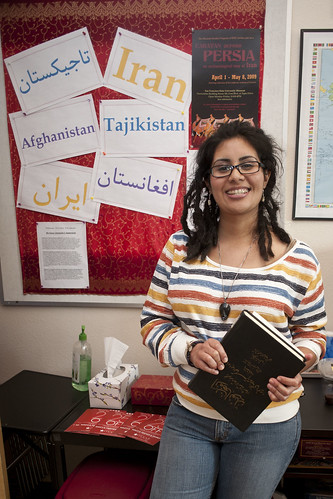On the fourth floor of the Humanities Building’s north end, an open door comes into view as soon as students and faculty reach the top of the stairs. The room, which houses the newly established Persian studiesoffice, is decorated thoughtfully with a plush rug, framed photographs of immaculate temples and informational posters outlining ancient philosophies.

The College of Liberal and Creative Arts will introduce a minor in Persian studies for the upcoming fall semester, making SF State the only school in the California State University system to offer such a discipline. What began as an academic endeavor six years ago is finally being seen to fruition, even in the midst of turbulence caused by a diminishing budget and consolidated colleges.
Persian studies founding director Mirta Ara crafted her proposal to create the program, and the following year she presented it to various CSUs in Northern California. According to Ara, SF State was the only university to show interest in adopting it, which she attributes in part to the support of Paul Sherwin, dean of the College of Liberal and Creative Arts.
“He had a vision of (the) importance of recognizing international studies,” Ara said. “He accepted the proposal, but we had to start small, offering a few courses.”
Such courses include 5-unit classes in Persian language, surveys on Persian media and literature and lectures on religious traditions in Iran.
According to Dean Sherwin, the suggestion of establishing Persian studies at SF State came at a time when the University sought to create a learning environment that reflected its diverse campus community. He said that in 2002, he supported the initiation of a minor in Middle Eastern and Islamic studies.
“There was a campus-wide initiative, an effort to internationalize the campus,” Sherwin said. “But if you’re going to specialize in the Middle East, you need to know the language.” Sherwin added that while the Middle Eastern Islamic studies program offered instruction in Arabic and Hebrew, there had not been an opportunity for students to learn Persian.
History graduate student David Eacker, 35, credits his knowledge of the Persian language, which he gained from having taken four semesters of it at SF State, with making him stand out when he applied and was accepted into a doctorate program in Middle Eastern studies at Indiana University.
Eacker noted the growing prominence of Middle Eastern and Islamic studies in larger schools.
“A lot of big universities are starting to ramp up Iranian studies, specifically. Central Eurasian and Persian studies are becoming a part of that. It would be great if CSUs can follow suit,” he said.
Aside from incorporating into the curriculum a language that, like Cantonese, Turkish and Russian, Sherwin described as “critical to the national security of the United States,” Ara notes the potential for Persian cultural classes to challenge negative portrayals of Middle Eastern countries.
“Especially after the events of September 11, there is an obvious need for the members of our society in the United States to grasp a better understanding of the culture of this region, ideologies of the people,” she said. “The urgency of it has been there for so long, but unfortunately, it hasn’t received the attention it needed. We haven’t trained our students.”
Ara emphasized the importance of learning subjects like philosophy, international relations and history in an academic setting, rather than through popular media.
“If we don’t address it at the university, we leave that education in the hands of Hollywood and news anchor individuals, and then we sit around and hope for peace,” she said.
Some students involved with the program have already dealt with others who question the presence of a Persian studies program on campus.
Mandana Saeedian, a 30-year-old biochemistry and molecular biology double major and Persian language tutor, turned what seemed like a confrontation into a learning opportunity.
“A woman came in (to the Persian studies office) angry about Persian studies, asking why we were teaching courses in it because we’re at war with them,” she said. What followed was a discussion on history and politics that lasted as long as 40 minutes, but Saeedian said that by the end, she had been able to alleviate some of the woman’s concerns.
“At first, she was angry, but then she began to understand,” Saeedian said.
Eacker, who is currently enrolled in a course on religious traditions in Iran, believes that questions like these are encouraged in class, especially when some students may not have a personal connection to the countries or cultures in focus.
“There are definitely people (in class) who are non-heritage students,” he said. “The questions are really illuminating in the sense that you’re learning about this place that’s a blank slate in people’s knowledge of world history.”
According to Sanam Darougar, a program coordinator for Persian studies, the diversity among students in terms of nationality and field of study is invaluable.
“This is not only a program for Persian students,” Darougar said. “We want to promote internationalism and interculturalism, and have a wide variety of students.”
Erika Alfaro is one such non-heritage student. While the nursing major has taken multiple Persian language classes, she admits that her initial introduction to the program was not planned.
“I’ve always wanted to learn another language; it was kind of spontaneous,” said Alfaro, 25.
She added that she has recently encountered many students from Iran which, combined with her aspiration to practice medicine in the Bay Area, solidified her decision to pursue Persian studies at the University.
“I wanted to broaden my perspective on the cultural aspects in Persia,” she said. “There’s a pretty big population in the Bay Area, populations I can potentially be taking care of as a nurse.”




